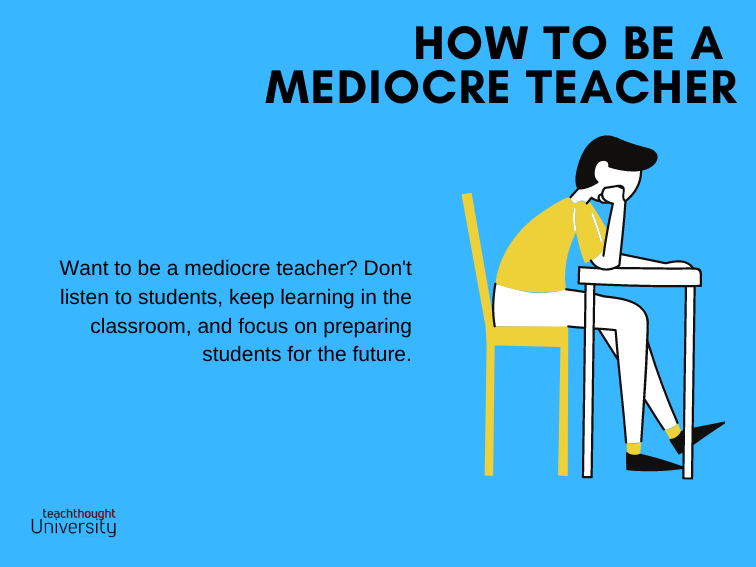
10 Ways To Be A Mediocre Teacher
Being a mediocre teacher isn’t easy.
It’s not clear if the same applies to police officers, dentists, airline pilots, or other professionals, but it seems true for educators.
Most educators either improve dramatically their first few years through a combination of effort, imagination, reflection, and constant professional development, or they leave the classroom entirely.
So you’ve got to admire the mediocre teacher in that they exist in schools at all. They’re the survivors in the school building, able to withstand crushing district programs, and decade after decade of government mandates to keep on keeping on. If there is ever a zombie apocalypse (or any kind of apocalypse for that matter), find the closest mediocre teacher and follow them.
So how does a teacher remain mediocre in the face so much opportunity to improve?
1. Try to please everyone
Parents, colleagues, principals, instructional coaches, district personnel, and your twitter-based Professional Learning Network will often have divergent ideas, agendas, and advice.
Do your best to fulfill all of their pleadings and demands, with very little sense of priority. When you’re a teacher, everyone is your boss.
2. Act alone
In education, as a teacher, you are the designer, actuator, judge, jury, and executioner. Instead of merely connecting students and the curriculum with the community, parents, administrators, and district officials, rather act as the spokesperson for it all.
Explain district policy to parents.
Justify school mediocrity to local business leaders. Be called to task by news media.
Advocate for personalized curriculum to audiences that won’t understand the need.
Insist on 21st-century technology for 21st-century learners in the face of budgets that can’t possibly sustain it.
Also, don’t make the mistake of creating a transparent curriculum so that all stakeholders can clearly see what’s happening when and pitch in accordingly. Instead, make it all go through you–and verbally if possible.
As the teacher, you’re in control. It is, after all, your classroom.
3. Keep the learning in the classroom
Dovetailing behind #2, whatever you do, never, ever design learning experiences so that learners and their families naturally work together. Keep the learning in the classroom where it can be measured and verified by an expensive (and resource-sapping) battery of tests.
4. Forget that you’re really there to serve students
You’re not there for the students as human beings—to spark, inspire, and intellectually care-take. Instead, believe that you’re there for the sake of the literacy rates and proficiency of the students. After all, that is being there for the students. They’ll thank you when they can read the dosage instruction on the medication they take because they’re 32 and making $28,000 a year in a soulless, life-sucking job and are forced to send their 3 children to schools and live in communities not much different than the ones that produced their life’s mediocre arc.
5. Believe that children are not books to be read, but books to be written
As adults, we know what’s best for students. We aren’t there to discover or assist in discovery, or support families in creating sustainable learning patterns for life-long self-improvement, but rather to help students master content. We were brought up the same way, and by golly look at us. All healthy, thriving, well-balanced adults changing the world one student at a time. Yeehaw.
6. Prepare students for the future!
Be sure to project your insecurities on the students to help brace them for what’s coming, rather than the world they live and breathe in now. Prepare them for the uncertain future!
7. Use the same (or extremely similar) units and lessons each year
The great thing about teaching is, once you get through the first year, it gets so much easier, Your units and lessons are done. Assessments are finished. Novels are chosen, projects are designed, guest-speakers are selected, field trips are planned. You’re on cruise control. You may need to go in and tweak things here or there, but learning is learning, am I right?
No need to reinvent the wheel. Stick with what works!
8. Don’t ask the students for ideas
Asking the students for ideas gives students the illusion that they are in control, or have anything but a superficial investment in the learning process. Passivity is so much easier for classroom management! What kinds of ideas would they come up with anyway? Free homework passes, open-book tests, and a marathon of Jersey Shore, Call of Duty, and Spongebob Squarepants.
The fact that students can’t even begin to come up with the first compelling idea for learning says nothing about how long ago they “checked out” of the learning process. It’s because they’re kids! When they start paying some bills, then they’ll understand what real responsibility is.
9. Give very little attention to tiering, scaffolding, or student choice
Scaffolding helps all learners work within their Zone of Proximal Development. Tiering is a super simple process that helps create lessons and assessments or using innovative grouping strategies, but it only makes more work for you. Who has the time?!
10. Minimize reflection and metacognition
Reflection is perhaps the most powerful of all improvement strategies. Formally and informally taking a look back at what happened—after a Socrative Discussion, a day, or a unit—is for people that have time.
If mediocrity is what you’re after, conjure up only brief little episodes of reflection—and then, either feel sorry for yourself for how awful it went or ignore the data and focus on all the ‘feel good’ moments. You’re never as good as you think you are, and you’re never as bad as you think you are either.
Or that’s the lie going around anyway.
How To Be A Mediocre Teacher
